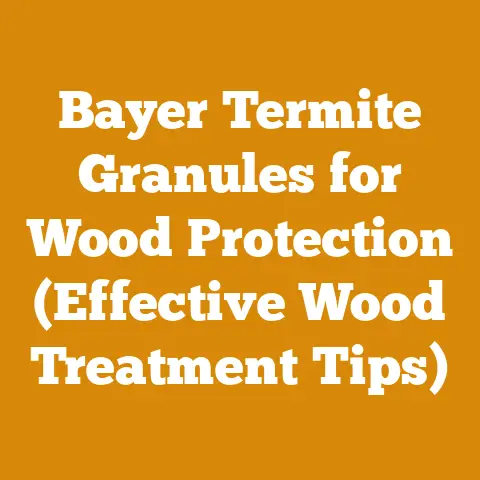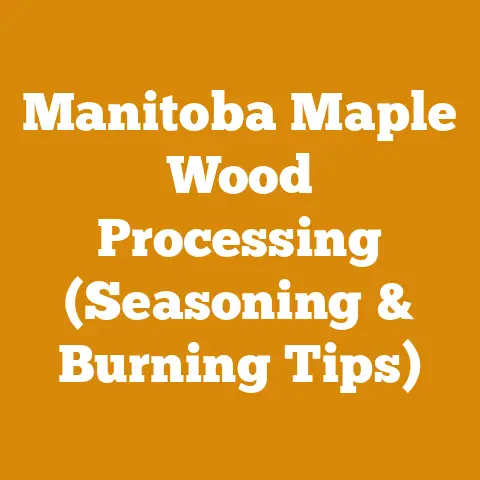Herbicide for Grass Only (5 Pro Tips for Safe Tree Care)
I’ve seen firsthand how easily grass can encroach and stress young trees or even mature ones. This isn’t just about aesthetics; it’s about the long-term health and vitality of your trees. Using herbicides selectively for grass control can be a valuable tool, but it’s crucial to do it safely and effectively. That’s why I’ve put together these five pro tips, drawing from my years of experience in woodlot management and tree care.
1. Know Your Herbicide: Selecting the Right Tool for the Job
The first and most crucial step is understanding herbicides. They aren’t all created equal. You need to choose a product specifically designed to target grasses without harming broadleaf plants (like your trees!).
- Selective vs. Non-Selective: Selective herbicides target specific types of plants, while non-selective herbicides kill almost anything they come into contact with. For this application, you must use a selective herbicide labeled for grass control around trees. I cannot stress this enough. Using a non-selective herbicide like glyphosate (Roundup) without extreme caution is a recipe for disaster.
- Active Ingredients to Look For: Look for herbicides containing active ingredients like sethoxydim, fluazifop, or clethodim. These are commonly found in grass-specific herbicides. Always read the label carefully to ensure it’s safe for use around the specific tree species you’re trying to protect.
- Reading the Label: I know it’s tempting to skip the fine print, but the herbicide label is your bible. It provides crucial information on application rates, safety precautions, target weeds, and environmental considerations. Ignoring the label can lead to ineffective weed control, damage to your trees, or even legal issues.
- My Personal Experience: I once witnessed a neighbor accidentally kill several young apple trees by using a non-selective herbicide to clear grass around the base. The sight of those trees wilting and dying was a harsh lesson in the importance of proper herbicide selection.
Takeaway: Choose a selective herbicide specifically designed for grass control around trees. Always read and understand the product label before application.
2. Timing is Everything: When to Apply for Maximum Effectiveness
The timing of your herbicide application can significantly impact its effectiveness and the safety of your trees.
- Optimal Application Window: Generally, the best time to apply grass-specific herbicides is when the grass is actively growing. This typically occurs in the spring and early fall when temperatures are moderate and moisture is adequate. Avoid applying herbicides during periods of drought or extreme heat, as the grass may be stressed and less susceptible to the herbicide.
- Avoiding Tree Bud Break: Never apply herbicides when your trees are actively budding or flowering. This is a particularly vulnerable time for trees, and they are more susceptible to herbicide damage. Wait until the new growth has hardened off before applying any herbicides.
- Weather Conditions: Avoid applying herbicides on windy days, as drift can carry the herbicide to non-target plants, including your trees. Also, avoid applying herbicides before heavy rain, as the rain can wash the herbicide away before it has a chance to be absorbed by the grass.
- My Experience with Timing: I once made the mistake of applying herbicide on a slightly windy day. Despite my best efforts, some of the herbicide drifted onto the leaves of a nearby maple tree, causing some minor leaf damage. It was a valuable reminder that even a slight breeze can carry herbicide droplets a considerable distance.
Takeaway: Apply grass-specific herbicides when the grass is actively growing, avoiding periods of tree bud break, windy conditions, or impending rainfall.
3. Precision Application: Protecting Your Trees from Harm
The key to safe herbicide use around trees is precision application. You want to target the grass while minimizing the risk of exposing your trees to the herbicide.
- Shielding and Barriers: Use physical barriers, such as cardboard shields or plastic sheeting, to protect the trunks and lower branches of your trees during application. This is especially important for young trees with thin bark that is more susceptible to herbicide absorption.
- Directed Sprays: Use a low-pressure sprayer with a narrow nozzle to apply the herbicide directly to the grass, avoiding overspray onto the trees. Consider using a spray shield attachment to further minimize drift.
- Hand-Wiping or Painting: For small areas or individual clumps of grass, consider hand-wiping or painting the herbicide onto the grass blades. This method allows for extremely precise application and minimizes the risk of off-target exposure. Wear appropriate gloves and eye protection when using this method.
- Granular Herbicides: Some grass-specific herbicides are available in granular form. These can be applied using a spreader or by hand, but be careful to avoid getting granules on the leaves or bark of your trees.
- My Personal Tip: I often use a small paintbrush to apply herbicide to individual weeds growing close to the base of trees. It’s a bit tedious, but it’s incredibly effective and minimizes the risk of damage.
Takeaway: Employ precision application techniques, such as shielding, directed sprays, hand-wiping, or painting, to protect your trees from herbicide exposure.
4. Dosage and Concentration: Less is Often More
Applying too much herbicide can be just as harmful as using the wrong type. Always adhere to the recommended dosage and concentration rates specified on the product label.
- Following Label Instructions: The herbicide label provides specific instructions on how much herbicide to use per gallon of water or per square foot of treated area. These instructions are based on extensive testing and are designed to provide effective weed control without harming desirable plants.
- Calibrating Your Sprayer: Before applying any herbicide, calibrate your sprayer to ensure it is delivering the correct amount of product. This involves measuring the amount of liquid sprayed over a known area and adjusting the sprayer settings accordingly.
- Spot Treatments: For small areas or individual weeds, consider using spot treatments instead of blanket applications. This reduces the overall amount of herbicide used and minimizes the risk of off-target exposure.
- The “Less is More” Philosophy: It’s always better to err on the side of caution and use a lower concentration of herbicide than to risk damaging your trees. You can always reapply the herbicide later if necessary, but you can’t undo the damage caused by over-application.
- A Costly Mistake: I once saw a landscaper apply an herbicide at twice the recommended concentration in an attempt to “get rid of the weeds faster.” The result was widespread damage to the surrounding plants, including several valuable shrubs. It was a costly mistake that could have been easily avoided by following the label instructions.
Takeaway: Always adhere to the recommended dosage and concentration rates specified on the herbicide label. Calibrate your sprayer and consider using spot treatments to minimize herbicide use.
5. Post-Application Care: Monitoring and Maintenance
After applying herbicide, it’s important to monitor your trees for any signs of stress or damage.
- Observing Your Trees: Keep a close eye on your trees for several weeks after herbicide application. Look for signs of leaf discoloration, wilting, stunted growth, or bark damage. If you notice any of these symptoms, consult with a certified arborist or horticultural expert to determine the cause and take appropriate action.
- Watering and Fertilizing: Ensure your trees are adequately watered and fertilized to promote healthy growth and resilience. Healthy trees are better able to withstand the stress of herbicide exposure.
- Mulching: Apply a layer of organic mulch around the base of your trees to help suppress weed growth, retain moisture, and improve soil health. Avoid piling mulch directly against the tree trunk, as this can create a favorable environment for pests and diseases.
- Record Keeping: Keep a record of all herbicide applications, including the date, time, product used, dosage, and weather conditions. This information can be valuable for future reference and can help you identify any potential problems.
- Learning from Experience: I always keep a detailed log of my herbicide applications, noting the results and any observed effects on the trees. This helps me refine my techniques and make informed decisions about future applications.
Takeaway: Monitor your trees for signs of stress or damage after herbicide application. Provide adequate watering and fertilization, and apply a layer of organic mulch.
Understanding Herbicide Formulations and Their Impact
Beyond selecting the right active ingredient, understanding herbicide formulations is crucial for safe and effective use around trees. Different formulations have different properties that affect how they are absorbed by plants and how they behave in the environment.
- Emulsifiable Concentrates (EC): These formulations contain the herbicide dissolved in a solvent and require mixing with water before application. EC formulations can penetrate plant surfaces more readily than other formulations, but they can also be more volatile and prone to drift.
- Wettable Powders (WP): These formulations consist of finely ground herbicide particles that are suspended in water. WP formulations are less prone to drift than EC formulations, but they can be more difficult to mix and may leave a visible residue on plant surfaces.
- Granules (G): These formulations consist of herbicide coated onto a granular carrier. Granular herbicides are easy to apply and less prone to drift than liquid formulations, but they require moisture to activate and may not be as effective on established weeds.
- Water-Dispersible Granules (WDG): These formulations are similar to wettable powders, but the herbicide particles are formed into granules that disperse readily in water. WDG formulations offer a good balance of ease of use, low drift potential, and effectiveness.
- My Recommendation: For most situations, I prefer using water-dispersible granule (WDG) formulations. They are relatively easy to mix, have low drift potential, and provide good weed control.
Takeaway: Understand the different herbicide formulations and choose the one that is most appropriate for your specific situation.
Safety First: Protecting Yourself and the Environment
Using herbicides safely requires taking precautions to protect yourself, your family, and the environment.
- Personal Protective Equipment (PPE): Always wear appropriate PPE when handling and applying herbicides, including gloves, eye protection, long sleeves, long pants, and closed-toe shoes. A respirator may be necessary when applying certain herbicides in enclosed spaces.
- Storage and Disposal: Store herbicides in a secure location out of reach of children and pets. Dispose of empty herbicide containers according to the manufacturer’s instructions and local regulations. Never pour leftover herbicide down the drain or into the environment.
- Environmental Considerations: Avoid applying herbicides near waterways or sensitive areas. Consider using alternative weed control methods, such as hand-weeding or mulching, whenever possible.
- Communicating with Neighbors: If you live in a residential area, inform your neighbors before applying herbicides, especially if they have children or pets.
- A Close Call: I once had a close call when I accidentally splashed some herbicide on my skin while mixing it. Fortunately, I was wearing gloves and long sleeves, so the exposure was minimal. I immediately washed the affected area with soap and water and experienced no adverse effects. This incident reinforced the importance of wearing proper PPE when handling herbicides.
Takeaway: Prioritize safety when handling and applying herbicides. Wear appropriate PPE, store and dispose of herbicides properly, and consider environmental factors.
Alternative Weed Control Methods: Reducing Herbicide Use
While herbicides can be a valuable tool for controlling grass around trees, they should not be the only option. Consider using alternative weed control methods to reduce your reliance on herbicides.
- Mulching: Applying a thick layer of organic mulch around the base of your trees can effectively suppress weed growth, retain moisture, and improve soil health.
- Hand-Weeding: Regularly hand-weeding around your trees can prevent weeds from becoming established and reduce the need for herbicides.
- Cover Crops: Planting cover crops, such as clover or buckwheat, around your trees can help suppress weed growth and improve soil fertility.
- Mechanical Weed Control: Using tools such as hoes or cultivators to remove weeds can be an effective alternative to herbicides, especially in larger areas.
- Integrated Pest Management (IPM): IPM is a holistic approach to pest management that combines multiple strategies, including cultural practices, biological control, and chemical control, to minimize the use of pesticides.
- My Preferred Approach: I prefer using a combination of mulching, hand-weeding, and cover crops to control weeds around my trees. This approach minimizes the need for herbicides and promotes healthy soil and tree growth.
Takeaway: Consider using alternative weed control methods, such as mulching, hand-weeding, cover crops, and mechanical weed control, to reduce your reliance on herbicides.
Dealing with Specific Grass Types: A Targeted Approach
Different types of grasses may require different herbicide treatments. Identifying the specific grass species you are dealing with can help you choose the most effective herbicide and application method.
- Annual Grasses: Annual grasses, such as crabgrass and foxtail, germinate from seed each year and are typically easier to control than perennial grasses.
- Perennial Grasses: Perennial grasses, such as quackgrass and Bermuda grass, spread through rhizomes or stolons and are more difficult to control.
- Identifying Grass Species: Use a field guide or online resource to identify the specific grass species you are dealing with. Knowing the grass species will help you choose the most effective herbicide.
- Herbicide Selection: Some herbicides are more effective on certain grass species than others. Consult the herbicide label or a local expert to determine which herbicide is best for your target grass.
- Sequential Applications: For perennial grasses, you may need to make sequential herbicide applications to achieve effective control.
- A Challenging Case: I once struggled to control a patch of quackgrass that had invaded my garden. After trying several different herbicides with limited success, I finally consulted with a local agricultural extension agent who recommended a specific herbicide and application method. With the agent’s help, I was able to eradicate the quackgrass and prevent it from spreading.
Takeaway: Identify the specific grass species you are dealing with and choose an herbicide that is effective against that species. Consider sequential applications for perennial grasses.
Troubleshooting Common Problems: Addressing Herbicide Issues
Even with careful planning and execution, you may encounter problems when using herbicides around trees. Here are some common issues and how to address them.
- Herbicide Resistance: Over time, some weeds can develop resistance to certain herbicides. If you notice that an herbicide is no longer effective, switch to a different herbicide with a different mode of action.
- Phytotoxicity: Phytotoxicity refers to damage to plants caused by herbicides. Symptoms of phytotoxicity can include leaf discoloration, wilting, stunted growth, and even death. If you suspect phytotoxicity, stop applying the herbicide immediately and consult with a certified arborist or horticultural expert.
- Drift: Herbicide drift can occur when the herbicide is carried by wind to non-target plants. To minimize drift, apply herbicides on calm days, use a low-pressure sprayer, and consider using a spray shield attachment.
- Soil Contamination: Herbicides can contaminate the soil if they are applied improperly or if they leach through the soil profile. To minimize soil contamination, follow the label instructions carefully and avoid applying herbicides near waterways or sensitive areas.
- Seeking Expert Advice: If you encounter problems that you cannot resolve on your own, consult with a certified arborist, horticultural expert, or agricultural extension agent. These professionals can provide valuable advice and guidance.
- A Learning Experience: I once experienced a problem with herbicide resistance in my vegetable garden. After several years of using the same herbicide to control weeds, I noticed that the weeds were no longer being affected. I consulted with a local agricultural extension agent who explained that the weeds had developed resistance to the herbicide. He recommended switching to a different herbicide with a different mode of action, which solved the problem.
Takeaway: Be aware of common herbicide problems, such as herbicide resistance, phytotoxicity, drift, and soil contamination. Seek expert advice when needed.
The Future of Weed Control: Sustainable Practices
As environmental concerns continue to grow, there is increasing interest in developing more sustainable weed control practices.
- Organic Herbicides: Organic herbicides are derived from natural sources, such as plants or microorganisms. While organic herbicides may be less effective than synthetic herbicides, they are generally considered to be safer for the environment and human health.
- Biocontrol Agents: Biocontrol agents are living organisms, such as insects or fungi, that are used to control weeds. Biocontrol agents can be highly effective, but they may not be suitable for all situations.
- Precision Weed Control: Precision weed control involves using technology, such as GPS and sensors, to target weeds with herbicides only where they are needed. This approach can significantly reduce the amount of herbicide used and minimize environmental impact.
- Robotics: Robots are being developed to automate weed control tasks, such as hand-weeding and spot spraying. Robots can be more efficient and precise than humans, and they can reduce the need for herbicides.
- My Vision: I believe that the future of weed control will involve a combination of sustainable practices, including organic herbicides, biocontrol agents, precision weed control, and robotics. By adopting these practices, we can protect our trees and the environment while still effectively managing weeds.
Takeaway: Stay informed about the latest developments in sustainable weed control practices and consider incorporating these practices into your tree care program.
- Regular Inspections: Regularly inspect your trees for signs of stress, disease, or pest infestation. Early detection and treatment can prevent serious problems.
- Proper Pruning: Prune your trees regularly to remove dead, damaged, or diseased branches. Proper pruning can improve air circulation and sunlight penetration, which can help prevent disease.
- Soil Testing: Conduct regular soil tests to determine the nutrient content of your soil. Amend the soil as needed to provide your trees with the nutrients they need to thrive.
- Watering: Water your trees deeply and regularly, especially during periods of drought.
- Consulting with Experts: Don’t hesitate to consult with a certified arborist or horticultural expert if you have questions or concerns about your trees.
- My Overall Philosophy: I believe that the key to successful tree care is to create a healthy environment that supports tree growth and resilience. This involves providing adequate water and nutrients, protecting trees from pests and diseases, and using sustainable practices whenever possible.
Takeaway: Take a holistic approach to tree care that includes proper watering, fertilization, pruning, pest management, and regular inspections. Consult with experts when needed.






